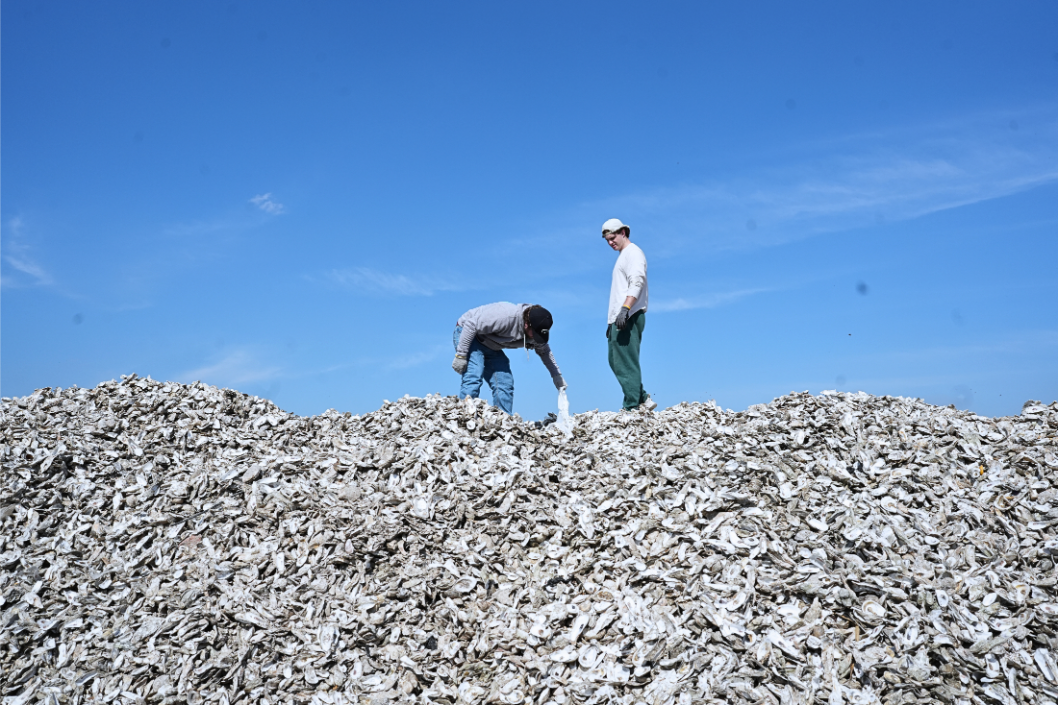
Marsh Madness Week 4: The Lifecycle of a "Used" Oyster
|
|
Time to read 4 min
|
|
Time to read 4 min
Welcome Back to Week 4 of Marsh Madness! We’ve made it to the final week of Marsh Madness, and we’re wrapping things up by diving into the incredible journey of a “used” oyster. This week, the Toadfish team joined SCDNR’s Trash Pickin’ Tuesday event to help sort through recycled oyster shells and remove any trash that might have been mixed in. But what exactly is a “used” oyster? It’s an oyster that’s been harvested, eaten, and properly discarded for recycling. These oysters are crucial to countless oyster restoration projects because oysters grow best on, well, other oyster shells. But before these shells can be reintroduced to the environment, they must be properly cleaned and quarantined. Let’s take a closer look at how these “used” oyster shells transform into a building block for conservation.
If you’ve ever enjoyed a dozen oysters at a Charleston raw bar, you might be surprised to learn that the shells from your plate often make their way back into our waterways. Restaurants like Leon’s, 167 Raw, The Darling Oyster Bar, and many others collect their used shells and set them out on the curb at close for SCDNR to pick up once or twice a week. A used oyster doesn’t go to waste—it enters a new stage of its lifecycle, becoming a key piece of restoration efforts. Oysters that come from restaurants, oyster roasts, or backyard shucking parties are all gathered for recycling by SCDNR, and while it might seem like a seamless process, ensuring that these shells make it back to the water is a process. So where does a used oyster go from here?
SCDNR collects oyster shells from two main sources: designated recycling sites and participating restaurants. Each day, thousands of shells are shucked and discarded, whether by recreational oyster eaters at home or professional shuckers in restaurants. To ensure these shells don’t end up in landfills, SCDNR runs a collection program, sending trucks and trailers around Charleston and other coastal areas to pick up bins of discarded shells.
The collection process is an ongoing effort that relies on community participation. Whether you’re dining out or hosting an oyster roast, making sure those shells end up in the right place is a small but impactful way to contribute to conservation. Want to learn more about where to drop off your used oyster shells? Click here: https://saltwaterfishing.sc.gov/oyster.html
Before these shells can return to the water, they need to be cleaned and quarantined. Introducing unprocessed shells into the ecosystem could bring unwanted bacteria, diseases, or even plastic waste. To prevent this, all collected oyster shells must sit in the sun for at least six months. This natural quarantine process kills off any harmful bacteria and ensures the shells are safe for reuse.
Another crucial step in this process is sorting through the non-biodegradable waste that gets mixed in. You’d be amazed at what ends up in oyster recycling bins - at our event, we found napkins, plastic utensils, cocktail sauce bottles, gloves, oyster knives, shucking gloves, and more! That’s why Trash Pickin’ Tuesday events like the one we attended are so important. Volunteers help sift through tens of thousands of oyster shells, removing anything that doesn’t belong. It’s a messy job, but a necessary one for keeping our waterways clean and healthy.
Once the shells have been properly quarantined, they’re ready for their next role in coastal conservation. SCDNR uses these shells in most of their restoration efforts such as shell bagging, Manufactured Wire Reefs (MWRs), and shell spraying. Each method has unique benefits, but they all work toward the same goal: facilitating new oyster habitats and promoting oyster reef growth.
Oysters have this superpower that has a massive impact on water quality—an adult oyster can filter up to 50 gallons of water per day. When we rebuild oyster reefs, we amplify this effect. More oysters mean cleaner water, healthier habitats, and stronger ecosystems. The impact is exponential, making oyster recycling one of the most effective ways to support the health of our local waterways.
As we wrap up another year of Marsh Madness, we want to thank everyone who has tuned in, followed along, and supported these conservation efforts. We love getting out in the community, getting our hands dirty, and playing a direct role in restoring our coastal ecosystems.
With the weather warming you, hopefully, you are going to be spending more and more time outdoors! As you do so, remember to be a steward of our waters—release big breeder fish, pick up your trash, handle fish properly, and recycle your oyster shells. Every small action adds up to a big impact.
Thanks again for joining us this year for Marsh Madness! If you enjoyed following along, let us know on social media or drop a comment. We appreciate your support as we continue working toward cleaner waters and stronger ecosystems. And as always, #PutEmBack!




